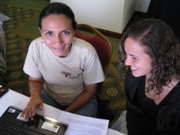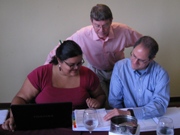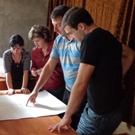Chapter 2 Summary of my complementary, 50 page e-book: Four Powerful 1st Steps in Designing & Funding Non Profit Projects.
Last week we looked at how to do a community needs assessment. This week we look at how to use the results of the needs assessment for cutting edge project design.
In the last newsletter we looked at how to use the results of a needs assessment to build a problem tree complete with overarching problems, their underlying causes, and the negative impacts. You can read that discussion here.
In this newsletter we will look for solution oriented activities for designing programs to solve the problems in the problem tree.
The example in this week’s newsletter is for a project for a food bank/pantry in Southern California. They used a participatory needs assessment with food bank clients to assess both need and potential improvements to the service they provide.
Theory of Change.
You concluded Assignment One with a set of community identified problems organized into a unique problem tree. You also wrote a short and concise description of the overall problem. Now is your opportunity to develop a theory of how to solve this problem, and to begin exploring specific activities that will fulfill your theory through discussions with colleagues, through your own experience, and through Internet searches.
A theory is just that. In the non-profit world it’s called a theory of change; it’s your theory of what changes in behavior, or changes in services and infrastructure will need to be realized to solve the problem (and its underlying causes). Your theory of change will include the interventions/activities that you are proposing will address the causes of the problem. This week we will also draft a goal statement that reflects our theory of change.
| First, identify potential solution oriented activities. | |
 |
We wrote out a list of the needs and challenges from last week’s assessment with space in between each one. Then we researched solution-oriented activities to each of the underlying causes. Our search uncovered scientific papers, articles, handbooks and manuals. You can search for information by:
|
| Next, look for families of activities for developing programs. | |
 |
Some of the documents you found will have numbered, sequential lists of activities: 8 Steps to More Food in your Food Bank. Select one list most appropriate for your non-profit and modify it to best fit your project’s context.
Then, think up a name for a solution-oriented program which will seek to solve one of your underlying causes. Then paste in the activity list below. The food bank is trying to increase food donations and food diversity too. Here is what their new program looks like this:
|
Restaurant and Grocery Store Donation Program [Solution to underlying cause: No program in place for collecting surplus food from restaurants and grocery stores]:
- Form a Restaurant and Grocery Store Donation team to assess feasibility and develop a plan
- Research different restaurant and grocery store donation programs and visit local food pantries, restaurants and grocery stores participating in programs
- Research product availability, transportation, pickup and delivery, and volunteer time requirements
- Survey community members to better understand products that they would enjoy from a program such as this
- Work with a nutritionist to better understand healthy products identified by restaurants and grocery stores
- Use this information to determine feasibility and develop a detailed working plan, budget and schedule
- Assess funding possibilities
- Launch a pilot program
Do this with the rest of the underlying causes in your project.
| Use your Problem Statement to develop a compelling Goal Statement | |
 |
If your problem statement is clear, concise, and simple, you will have a much easier time developing your goal. Your project’s goal statement will be phrased to be a positive reflection of your problem statement (somewhat like mirror images of each other) and at the same time offer a general strategy for a solution.
|
To create your compelling Goal Statement simply copy and paste your problem statement below your project outline—and without changing it structurally—make the negative words positive. This isn’t the introduction to a proposal, so it needs to be left clean and simple and an exact, parallel reflection of the problem statement.
You can download the instructions for designing your project and a finished example of the completed food bank project design at the top of this page.
There is also a link to a video on how to turn your problem tree and problem statement into a well thought out project design.
Please note:
This is part of the process for developing a project design is for a course I teach called OL 201, Designing and Funding Nonprofit Projects. The first two assignments in 201 include detailed instructions for conducting a live needs assessment, specific resources that you will need for conducting the assessment, an example of a completed assessment, and a project concept based upon the results.
I hope that you enjoy this. If you have a question don’t hesitate to contact us.
Sincerely,
Tim Magee

